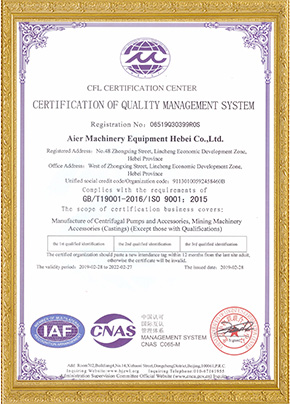Aug . 14, 2024 11:46 Back to list
Optimizing Pump Systems for Efficient Slurry Handling in Industrial Manufacturing Facilities
Understanding Slurry Pumps for Industrial Applications
In various industrial sectors, the transport of slurries—mixtures of solid particles and liquids—is a common requirement. Applications ranging from mining and mineral processing to wastewater management necessitate effective equipment designed to handle these complex mixtures. Slurry pumps emerge as a key solution, bridging the gap between ideal performance and robust engineering in factories dealing with slurries.
The Role of Slurry Pumps
Slurry pumps are specially designed to move slurries, which often contain abrasive materials. Unlike standard pumps that may be used for clean liquids, slurry pumps must contend with varying viscosities, solid concentrations, and particle sizes. The primary function of these pumps is to ensure the efficient transfer of slurry from one location to another, whether it is within the confines of a processing plant, from a mine to a treatment facility, or even in applications involving dredging.
Design Features of Slurry Pumps
The design of slurry pumps incorporates features that enhance their durability and performance. Typically, these pumps are built with a robust casing and heavy-duty impellers to withstand the abrasive nature of the materials they handle. Materials like high-chrome iron or elastomers are common in construction, as they provide greater wear resistance and longevity. Additionally, the hydraulics of slurry pumps are optimized to accommodate high concentrations of solids, ensuring that blockages and wear are minimized over time.
One key design aspect is the use of a low-shear impeller. This feature is crucial as it allows the pump to maintain a consistent flow rate without damaging the slurry's particle structure, which can be particularly important in applications like food processing or pharmaceuticals.
Types of Slurry Pumps
pump for slurry factories

There are primarily two types of slurry pumps used in factories centrifugal and positive displacement pumps. Centrifugal slurry pumps are the most common; they utilize rotational energy to move the slurry. These pumps are typically used in applications where a consistent flow is needed, making them ideal for continuous operations like mineral processing.
Positive displacement pumps, on the other hand, are used in scenarios where higher viscosity slurries are present. They work by trapping a fixed amount of slurry and then forcing it out through the discharge pipe, providing excellent suction capabilities and maintaining high pressure.
Challenges in Slurry Pump Operations
Operating slurry pumps is not without its challenges. The abrasive nature of slurries can lead to excessive wear on pump components, necessitating regular maintenance and potential replacement of parts. Moreover, the viscosity and solid contents of slurries can vary, requiring careful monitoring and potential adjustment of pump settings to ensure efficiency.
Another challenge is the potential for clogging, especially when handling larger solid particles. To mitigate this risk, many factories invest in advanced screening and filtration systems that pre-treat slurries before they enter the pump, thus extending the life of the equipment and ensuring consistent performance.
Conclusion
In conclusion, slurry pumps play a vital role in the functionality and efficiency of factories dealing with slurry transport. Their robust design, specialized materials, and adaptability to different slurry types make them indispensable in various industrial applications. As technology progresses, innovations in pump design and materials continue to enhance the effectiveness of slurry pumps, ensuring they remain a cornerstone of industrial processing for years to come. Proper selection, maintenance, and operation of these pumps are crucial for optimizing productivity and minimizing operational costs in slurry-intensive environments.
-
High Quality Slurry Pump Seals Reliable China Suppliers & Manufacturers
NewsJun.24,2025
-
High Quality Portable Submersible Slurry Pump Supplier & Manufacturer from China
NewsJun.10,2025
-
Slurry Pump Parts Manufacturer – High Quality Rubber Spare Parts from China
NewsJun.10,2025
-
High Quality 1/3 HP Submersible Sump Pump with Vertical - Reliable Supplier & Factory Price
NewsJun.10,2025
-
High-Efficiency Centrifugal Slurry Pumps India
NewsJun.10,2025
-
High Quality Warman Centrifugal Slurry Pump Suppliers & Factory
NewsJun.10,2025
